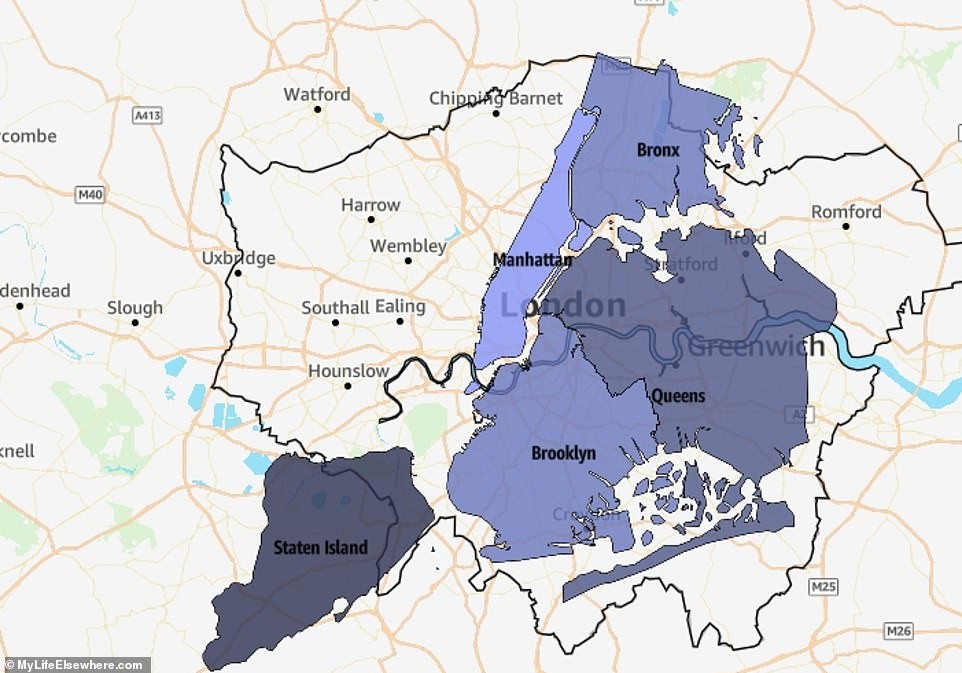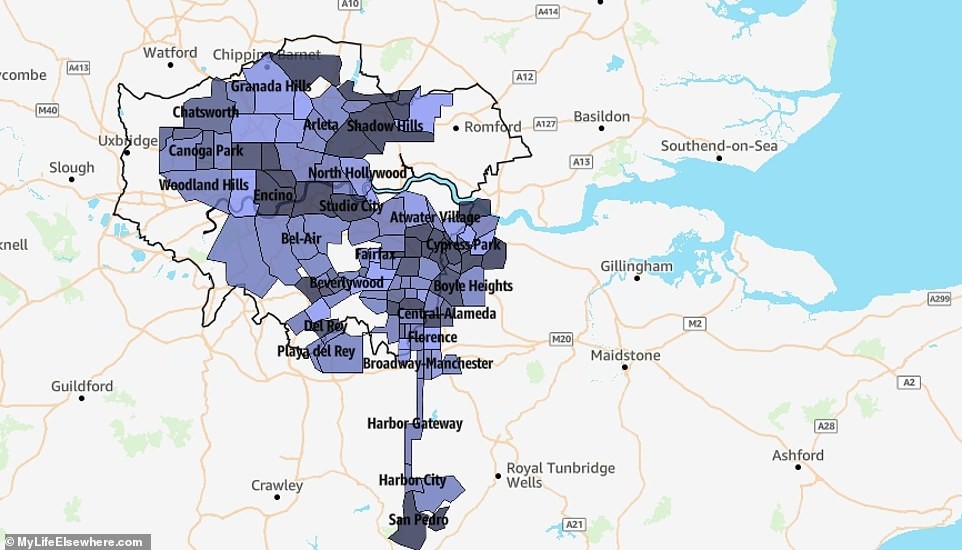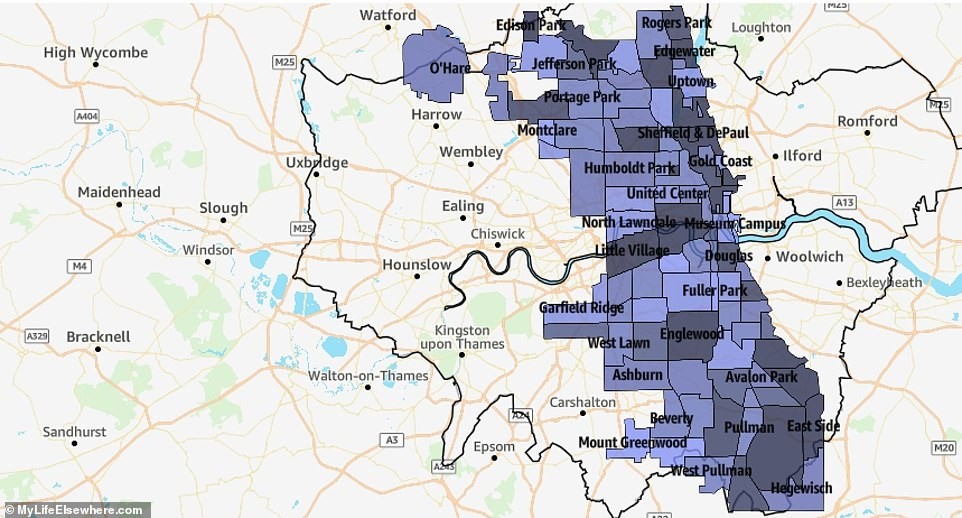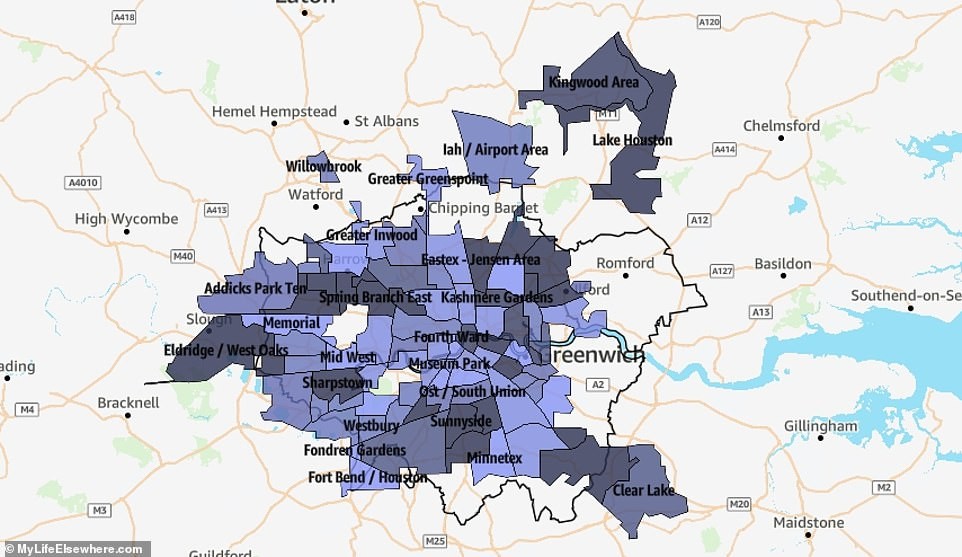How Big Is London Compared To Us Cities? London, a global hub of culture and commerce, often sparks curiosity regarding its size compared to major cities in the United States. COMPARE.EDU.VN provides a comprehensive exploration of London’s expanse, offering a detailed comparison to various urban centers across the US, helping you understand the scale and scope of this iconic metropolis. Explore detailed analyses, city size comparisons, and urban area assessments to gain a deeper understanding.
1. Understanding London’s Size
London, the capital of England and the United Kingdom, is a sprawling metropolis with a rich history and diverse culture. Understanding its size is crucial before comparing it to US cities.
1.1. Geographical Overview of London
London covers an area of approximately 1,572 square kilometers (607 square miles). This includes the 32 boroughs of Greater London, each contributing to the city’s overall character and functionality. The River Thames meanders through its heart, adding to the city’s unique geography.
1.2. Population Density
With a population of over 9 million, London boasts a high population density. This density varies across different boroughs, with some areas being more crowded than others. The city’s population density contributes to its vibrant and bustling atmosphere.
1.3. Factors Contributing to London’s Size
Several factors contribute to London’s extensive size. These include its historical growth, urban planning policies, and the incorporation of surrounding areas into Greater London. The city’s continuous expansion has shaped its current geographical footprint.
2. Comparing London to Major US Cities
To truly grasp the scale of London, it’s essential to compare it to some of the most prominent cities in the United States.
2.1. London vs. New York City
New York City, known for its iconic skyline and cultural diversity, covers an area of about 784 square kilometers (303 square miles). This makes London approximately twice the size of New York City. Despite New York’s towering skyscrapers, London’s sprawl encompasses a larger geographical area.
2.2. London vs. Los Angeles
Los Angeles, famous for its sprawling suburbs and entertainment industry, covers an area of around 1,215 square kilometers (469 square miles). London is approximately 1.3 times larger than Los Angeles. This difference highlights London’s substantial size relative to another major US city.
2.3. London vs. Chicago
Chicago, located on the shores of Lake Michigan, covers an area of about 606 square kilometers (234 square miles). London is approximately 2.6 times larger than Chicago. This comparison underscores London’s significant size advantage over one of the largest cities in the Midwest.
2.4. London vs. Houston
Houston, known for its energy industry and diverse population, covers an area of about 1,659 square kilometers (640 square miles). While Houston is one of the largest cities in the US by land area, it is only slightly larger than London, which covers approximately 1,572 square kilometers (607 square miles). This close comparison emphasizes the massive size of both metropolises.
2.5. London vs. Philadelphia
Philadelphia, a city steeped in American history, covers an area of about 369 square kilometers (142 square miles). London is approximately 4.3 times larger than Philadelphia. This vast difference highlights the sheer scale of London compared to one of the oldest cities in the United States.
3. Detailed Size Comparisons: Tables and Metrics
To provide a clear and concise comparison, here’s a table outlining the sizes of London and several major US cities:
| City | Area (Square Kilometers) | Area (Square Miles) |
|---|---|---|
| London | 1,572 | 607 |
| New York City | 784 | 303 |
| Los Angeles | 1,215 | 469 |
| Chicago | 606 | 234 |
| Houston | 1,659 | 640 |
| Philadelphia | 369 | 142 |
| Phoenix | 1,341 | 518 |
| San Antonio | 1,206 | 466 |
| San Diego | 964 | 372 |
| Dallas | 881 | 340 |
| San Jose | 466 | 180 |
| Austin | 825 | 319 |
| Jacksonville | 2,264 | 874 |
| San Francisco | 121 | 47 |
| Columbus | 577 | 223 |
| Charlotte | 798 | 308 |
| Indianapolis | 963 | 372 |
| Seattle | 369 | 142 |
| Denver | 401 | 155 |
| Washington D.C. | 177 | 68 |
| Boston | 125 | 48 |
| Nashville | 1,362 | 526 |
| Baltimore | 238 | 92 |
| Oklahoma City | 1,607 | 620 |
| Las Vegas | 352 | 136 |
| Milwaukee | 251 | 97 |
| Albuquerque | 491 | 190 |
| Tucson | 599 | 231 |
| Fresno | 303 | 117 |
| Sacramento | 259 | 100 |
| Long Beach | 133 | 51 |
| Kansas City | 826 | 319 |
| Mesa | 324 | 125 |
| Atlanta | 343 | 133 |
| Virginia Beach | 1,288 | 497 |
| Omaha | 339 | 131 |
| Minneapolis | 151 | 58 |
| Colorado Springs | 504 | 195 |
| Arlington | 67 | 26 |
| Raleigh | 371 | 143 |
| Miami | 143 | 55 |
| Oakland | 145 | 56 |
| Tulsa | 520 | 201 |
| Cleveland | 213 | 82 |
| New Orleans | 907 | 350 |
| Wichita | 423 | 163 |
| Tampa | 291 | 112 |
| Aurora | 401 | 155 |
| Honolulu | 177 | 68 |
| Anaheim | 131 | 51 |
| Pittsburgh | 151 | 58 |
| Santa Ana | 70 | 27 |
| Cincinnati | 206 | 80 |
| St. Louis | 171 | 66 |
| Orlando | 306 | 118 |
| Irvine | 181 | 70 |
| Newark | 67 | 26 |
| Stockton | 168 | 65 |
| Henderson | 279 | 108 |
| St. Paul | 134 | 52 |
| Greensboro | 341 | 132 |
| Lincoln | 249 | 96 |
| Plano | 187 | 72 |
| Buffalo | 136 | 53 |
| Fort Wayne | 287 | 111 |
| Jersey City | 55 | 21 |
| Chandler | 170 | 66 |
| Laredo | 262 | 101 |
| North Las Vegas | 262 | 101 |
| Durham | 288 | 111 |
| Madison | 264 | 102 |
| Norfolk | 140 | 54 |
| Baton Rouge | 230 | 89 |
| Lubbock | 320 | 124 |
| Irvine | 181 | 70 |
| Winston-Salem | 346 | 134 |
| Glendale | 119 | 46 |
| Garland | 148 | 57 |
| Scottsdale | 477 | 184 |
| Reno | 271 | 105 |
| Hialeah | 57 | 22 |
| Chesapeake | 909 | 351 |
| Gilbert | 177 | 68 |
| Cape Coral | 314 | 121 |
| Akron | 161 | 62 |
| Little Rock | 302 | 117 |
| Augusta | 794 | 307 |
| Shreveport | 306 | 118 |
| Mobile | 407 | 157 |
| Huntsville | 544 | 210 |
| Toledo | 218 | 84 |
| Syracuse | 66 | 25 |
| St. Petersburg | 160 | 62 |
| Anchorage | 441 | 170 |
| Richmond | 162 | 63 |
| Des Moines | 234 | 90 |
| Grand Rapids | 117 | 45 |
| Huntington Beach | 83 | 32 |
| Salt Lake City | 286 | 110 |
| Knoxville | 254 | 98 |
| Providence | 53 | 20 |
| Newport News | 178 | 69 |
| Fort Lauderdale | 99 | 38 |
| Tallahassee | 257 | 99 |
| Ontario | 134 | 52 |
| Vancouver | 115 | 44 |
| Cambridge | 18 | 7 |
| Ann Arbor | 74 | 29 |
| Berkeley | 45 | 17 |
| Palo Alto | 66 | 26 |
| Santa Monica | 22 | 8 |
| Pasadena | 60 | 23 |
| Savannah | 281 | 109 |
| Asheville | 117 | 45 |
| Boulder | 66 | 25 |
| Wilmington | 54 | 21 |
| Portland | 145 | 56 |
| Charleston | 349 | 135 |
| Boise | 210 | 81 |
| Worcester | 99 | 38 |
| Rochester | 96 | 37 |
| Hartford | 47 | 18 |
| Albany | 57 | 22 |
| Trenton | 8 | 3 |
| Honolulu | 177 | 68 |




3.1. Comparing Population Sizes
While land area provides one perspective, population size offers another crucial dimension for comparison.
| City | Population (Approximate) |
|---|---|
| London | 9,000,000+ |
| New York City | 8,400,000+ |
| Los Angeles | 4,000,000+ |
| Chicago | 2,700,000+ |
| Houston | 2,300,000+ |
| Philadelphia | 1,600,000+ |
3.2. Population Density Metrics
Population density (people per square kilometer or square mile) is an important metric to consider. London’s high density contributes to its vibrant urban environment.
| City | Population Density (per sq km) | Population Density (per sq mi) |
|---|---|---|
| London | 5,725 | 14,828 |
| New York City | 10,714 | 27,748 |
| Los Angeles | 3,275 | 8,483 |
| Chicago | 4,573 | 11,844 |
| Houston | 1,412 | 3,658 |
| Philadelphia | 4,421 | 11,450 |
4. Factors Influencing City Size
Several factors play a role in determining the size and sprawl of a city.
4.1. Historical Development
London’s historical growth, spanning over two millennia, has shaped its urban layout. The city’s expansion has been influenced by various eras, from Roman settlements to Victorian industrialization.
4.2. Urban Planning and Zoning Laws
Urban planning and zoning laws significantly influence a city’s size and shape. London’s planning policies have aimed to balance growth with preservation, affecting its overall geographical footprint.
4.3. Geographical Constraints
Geographical constraints, such as rivers, mountains, and bodies of water, can limit a city’s expansion. London’s location on the River Thames has both facilitated growth and presented challenges for urban development.
5. The Impact of Size on Urban Life
The size of a city has profound implications for its residents, economy, and environment.
5.1. Transportation and Commuting
In larger cities like London, transportation and commuting patterns are complex. The city’s extensive public transportation network, including the Underground, buses, and trains, is essential for managing the flow of people.
5.2. Housing and Cost of Living
City size affects housing availability and cost of living. London’s high demand for housing has led to increased prices and a diverse range of accommodation options, from apartments to houses.
5.3. Economic Opportunities
Larger cities often offer more diverse economic opportunities. London’s status as a global financial center and hub for various industries attracts professionals from around the world.
5.4. Cultural and Recreational Activities
The size of a city typically correlates with the availability of cultural and recreational activities. London boasts numerous museums, theaters, parks, and entertainment venues, catering to a wide range of interests.
6. Urban Sprawl: A Closer Look
Urban sprawl refers to the expansion of a city’s boundaries, often characterized by low-density development and reliance on automobiles.
6.1. Defining Urban Sprawl
Urban sprawl is characterized by the outward growth of a city, often resulting in the conversion of rural land into suburban or urban areas.
6.2. London’s Approach to Managing Sprawl
London has implemented various strategies to manage urban sprawl, including green belts, high-density development zones, and investments in public transportation.
6.3. Comparing Sprawl in London and US Cities
Compared to some US cities, London has been relatively successful in managing urban sprawl. Cities like Los Angeles and Houston are known for their extensive suburban sprawl, while London has maintained a more compact urban core.
7. The Future of Urban Size and Planning
As cities continue to grow, innovative approaches to urban planning will be essential.
7.1. Sustainable Urban Development
Sustainable urban development aims to create cities that are environmentally friendly, economically viable, and socially equitable. London has implemented various sustainability initiatives, including green building standards and renewable energy projects.
7.2. Smart City Technologies
Smart city technologies leverage data and digital tools to improve urban infrastructure, services, and quality of life. London is investing in smart city initiatives to enhance transportation, energy efficiency, and public safety.
7.3. The Role of Density in Future Cities
Increasing urban density can help reduce sprawl, improve transportation efficiency, and promote sustainable development. London’s approach to managing density will be crucial in shaping its future growth.
8. Case Studies: Specific Boroughs and US Neighborhoods
To provide a more granular comparison, let’s examine specific boroughs in London and neighborhoods in US cities.
8.1. Comparing Manhattan to the City of London
Manhattan, the iconic borough of New York City, is known for its high-density development and financial district. The City of London, the historic core of London, shares some similarities with Manhattan but has its unique character and history.
8.2. Comparing Brooklyn to Hackney
Brooklyn, a diverse borough of New York City, is known for its cultural vibrancy and residential neighborhoods. Hackney, a borough in London, shares some similarities with Brooklyn, offering a mix of residential areas, cultural attractions, and green spaces.
8.3. Comparing Queens to Brent
Queens, another borough of New York City, is known for its diverse population and suburban-like neighborhoods. Brent, a borough in London, shares some characteristics with Queens, offering a mix of residential areas, commercial centers, and green spaces.
9. London’s Green Spaces and Parks
Despite its large size, London boasts numerous green spaces and parks that enhance the quality of life for its residents.
9.1. Overview of London’s Parks
London is home to numerous parks, including Hyde Park, Regent’s Park, and Richmond Park. These parks provide recreational opportunities, green spaces, and habitats for wildlife.
9.2. Comparing Green Spaces in London and US Cities
Compared to some US cities, London offers a relatively high proportion of green space. Cities like New York City and Chicago also have significant parks, but London’s green spaces are integral to its urban landscape.
9.3. The Impact of Parks on Urban Wellbeing
Parks and green spaces contribute to urban wellbeing by providing opportunities for recreation, reducing stress, and improving air quality. London’s parks play a vital role in enhancing the quality of life for its residents.
10. How COMPARE.EDU.VN Can Help
Navigating the complexities of city comparisons can be challenging. COMPARE.EDU.VN offers comprehensive tools and resources to help you make informed decisions.
10.1. Accessing Detailed City Comparisons
COMPARE.EDU.VN provides detailed comparisons of cities, including size, population, cost of living, and quality of life. Our platform offers valuable insights for anyone considering relocating or simply curious about urban areas.
10.2. User-Friendly Comparison Tools
Our user-friendly comparison tools allow you to compare cities side-by-side, examining key metrics and factors. Whether you’re interested in job opportunities, housing costs, or cultural amenities, COMPARE.EDU.VN can help you find the information you need.
10.3. Expert Analysis and Insights
COMPARE.EDU.VN features expert analysis and insights from urban planners, economists, and other professionals. Our content is designed to provide you with a comprehensive understanding of urban dynamics and trends.
11. The Role of Technology in Urban Analysis
Technology plays a crucial role in modern urban analysis, providing tools for data collection, visualization, and modeling.
11.1. GIS and Mapping Technologies
Geographic Information Systems (GIS) and mapping technologies enable urban planners to analyze spatial data and create detailed maps of cities. These tools are essential for understanding urban sprawl, transportation patterns, and environmental impacts.
11.2. Data Analytics and Urban Modeling
Data analytics and urban modeling tools allow researchers to simulate urban growth, predict traffic patterns, and evaluate the impact of policy interventions. These technologies are valuable for informed decision-making in urban planning.
11.3. The Future of Urban Technology
The future of urban technology includes advancements in artificial intelligence, machine learning, and the Internet of Things. These technologies have the potential to revolutionize urban planning and improve the quality of life for city residents.
12. London’s Unique Urban Character
London possesses a unique urban character shaped by its history, culture, and diversity.
12.1. Historical Landmarks and Architecture
London is home to numerous historical landmarks, including the Tower of London, Buckingham Palace, and Westminster Abbey. These landmarks contribute to the city’s unique architectural heritage and cultural identity.
12.2. Cultural Diversity and Global Influence
London is one of the most culturally diverse cities in the world, with residents from various ethnic, religious, and linguistic backgrounds. The city’s global influence extends to finance, fashion, arts, and media.
12.3. The Blend of Tradition and Modernity
London seamlessly blends tradition and modernity, with historic buildings standing alongside contemporary skyscrapers. This juxtaposition of old and new contributes to the city’s unique appeal.
13. Comparing Infrastructure: London vs. US Cities
A crucial aspect of comparing cities is examining their infrastructure.
13.1. Transportation Infrastructure
London’s transportation infrastructure is extensive, including the London Underground, buses, trains, and trams. Comparing this to US cities reveals differences in public transportation options and reliance on automobiles.
13.2. Utility Infrastructure
Utility infrastructure, including water, electricity, and gas, is essential for urban functioning. London’s utility infrastructure has been modernized over the years to meet the needs of its growing population.
13.3. Digital Infrastructure
Digital infrastructure, including broadband internet and mobile networks, is increasingly important for urban economies. London has invested in digital infrastructure to support its status as a global technology hub.
14. Environmental Considerations
Environmental considerations are crucial for assessing the sustainability of cities.
14.1. Air Quality and Pollution
Air quality and pollution levels vary across cities. London has implemented measures to reduce air pollution, including congestion charges and low-emission zones.
14.2. Waste Management and Recycling
Effective waste management and recycling programs are essential for sustainable urban development. London has implemented various initiatives to increase recycling rates and reduce landfill waste.
14.3. Climate Change Adaptation
Climate change adaptation strategies are necessary for cities to mitigate the impacts of climate change. London has developed a climate action plan to address challenges such as rising sea levels and extreme weather events.
15. Economic Factors and City Size
Economic factors are closely linked to city size and growth.
15.1. GDP and Economic Output
Gross Domestic Product (GDP) and economic output are indicators of a city’s economic performance. London’s GDP is one of the highest in the world, reflecting its status as a global financial center.
15.2. Employment Opportunities
Employment opportunities vary across cities. London offers a wide range of job opportunities in finance, technology, media, and other industries.
15.3. Cost of Living and Affordability
Cost of living and affordability are important considerations for city residents. London is known for its high cost of living, particularly in terms of housing.
16. Social and Cultural Aspects
Social and cultural aspects contribute to the character of cities.
16.1. Cultural Institutions and Attractions
Cultural institutions and attractions enhance the quality of life for city residents. London boasts numerous museums, theaters, concert halls, and art galleries.
16.2. Diversity and Inclusion
Diversity and inclusion are important values for creating vibrant and equitable cities. London is one of the most diverse cities in the world, with residents from various backgrounds.
16.3. Community Engagement and Social Cohesion
Community engagement and social cohesion are essential for building strong and resilient cities. London has implemented various initiatives to promote community involvement and social interaction.
17. Crime Rates and Safety
Crime rates and safety levels are important considerations for city residents.
17.1. Comparing Crime Rates in London and US Cities
Comparing crime rates in London and US cities reveals differences in safety levels. Factors such as policing strategies, socioeconomic conditions, and community engagement can influence crime rates.
17.2. Safety Measures and Policing Strategies
Safety measures and policing strategies are implemented to reduce crime and improve safety. London has implemented various safety initiatives, including CCTV surveillance and community policing programs.
17.3. Perceptions of Safety
Perceptions of safety can influence the quality of life for city residents. Understanding how people perceive safety is important for addressing concerns and improving public trust.
18. Quality of Life Indicators
Quality of life indicators provide a holistic assessment of urban wellbeing.
18.1. Healthcare and Education
Healthcare and education systems are essential for promoting the wellbeing of city residents. London offers a range of healthcare services and educational institutions.
18.2. Access to Amenities and Services
Access to amenities and services, such as parks, libraries, and community centers, enhances the quality of life for city residents. London has invested in providing access to amenities and services across its boroughs.
18.3. Overall Wellbeing and Happiness
Overall wellbeing and happiness levels are subjective measures of quality of life. Understanding what contributes to wellbeing and happiness is important for creating thriving cities.
19. The Future of Urban Living
The future of urban living is shaped by trends in technology, sustainability, and social equity.
19.1. Trends in Urbanization
Trends in urbanization, such as population growth and migration patterns, influence the development of cities. Understanding these trends is important for planning for future growth.
19.2. The Impact of Remote Work
The rise of remote work has implications for urban economies and transportation patterns. Cities may need to adapt to changing work patterns and prioritize investments in digital infrastructure.
19.3. Visions for Future Cities
Visions for future cities include concepts such as smart cities, eco-cities, and resilient cities. These visions emphasize sustainability, technology, and community engagement.
20. Conclusion: Understanding the Size and Scale of Cities
Understanding the size and scale of cities is essential for making informed decisions about where to live, work, and invest. COMPARE.EDU.VN provides the resources and tools you need to explore urban dynamics and discover the best places to live.
20.1. Key Takeaways
- London is significantly larger than many major US cities in terms of land area.
- Population density varies across cities, impacting urban life and infrastructure.
- Urban sprawl is a challenge for many cities, requiring innovative planning solutions.
- Quality of life indicators provide a holistic assessment of urban wellbeing.
- The future of urban living is shaped by trends in technology, sustainability, and social equity.
20.2. Call to Action
Visit COMPARE.EDU.VN today to explore detailed city comparisons and discover the best places to live, work, and invest. Our comprehensive resources will help you make informed decisions and navigate the complexities of urban living.
Are you curious about how London stacks up against other global cities or want a more detailed comparison tailored to your specific needs? Head over to COMPARE.EDU.VN, where you’ll find in-depth analyses and comparison tools to explore various urban centers. Whether you’re planning a move, researching for a project, or simply intrigued by urban geography, COMPARE.EDU.VN offers the insights you need. Don’t make decisions without the full picture – visit us today at COMPARE.EDU.VN, located at 333 Comparison Plaza, Choice City, CA 90210, United States, or contact us via WhatsApp at +1 (626) 555-9090. Let COMPARE.EDU.VN be your guide to understanding and comparing the world’s cities.
FAQ: Comparing London and US Cities
Q1: How does London compare in size to New York City?
London is approximately twice the size of New York City in terms of land area.
Q2: Is London bigger than Los Angeles?
Yes, London is about 1.3 times larger than Los Angeles.
Q3: What factors contribute to London’s large size?
Factors include historical growth, urban planning policies, and the incorporation of surrounding areas into Greater London.
Q4: How does London manage urban sprawl?
London manages urban sprawl through green belts, high-density development zones, and investments in public transportation.
Q5: What are the key differences in transportation between London and US cities?
London has a more extensive public transportation network, while US cities often rely more on automobiles.
Q6: How does the cost of living in London compare to major US cities?
London is generally more expensive than most major US cities, particularly in terms of housing.
Q7: What are some of London’s major cultural attractions?
Major cultural attractions include the Tower of London, Buckingham Palace, and the British Museum.
Q8: How does London compare to US cities in terms of crime rates?
Crime rates vary, but London generally has lower crime rates compared to some major US cities.
Q9: What sustainable initiatives has London implemented?
London has implemented green building standards, renewable energy projects, and low-emission zones.
Q10: Where can I find more detailed comparisons of cities?
Visit compare.edu.vn for comprehensive city comparisons and expert analysis.
